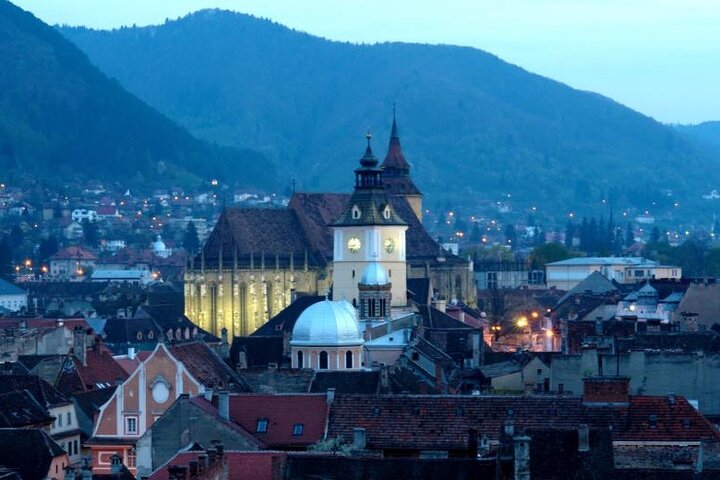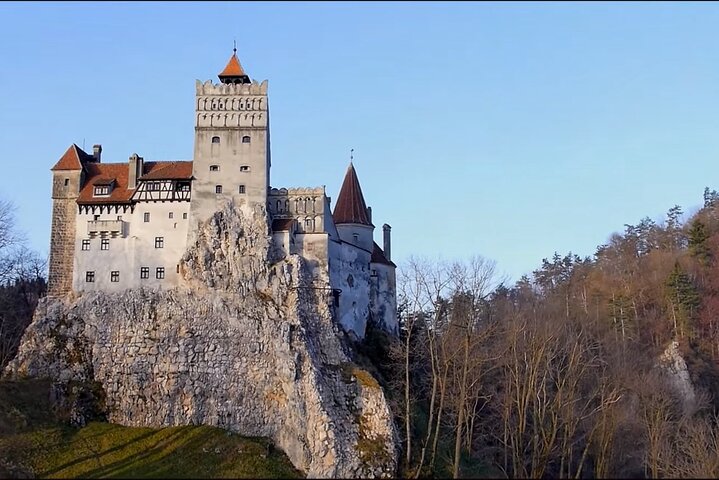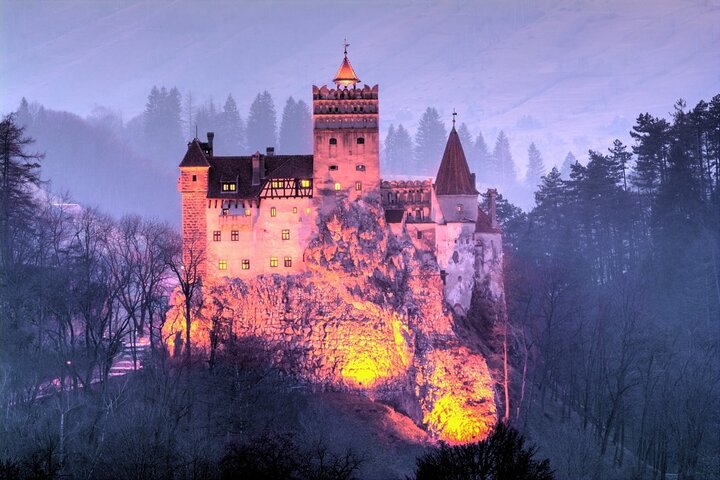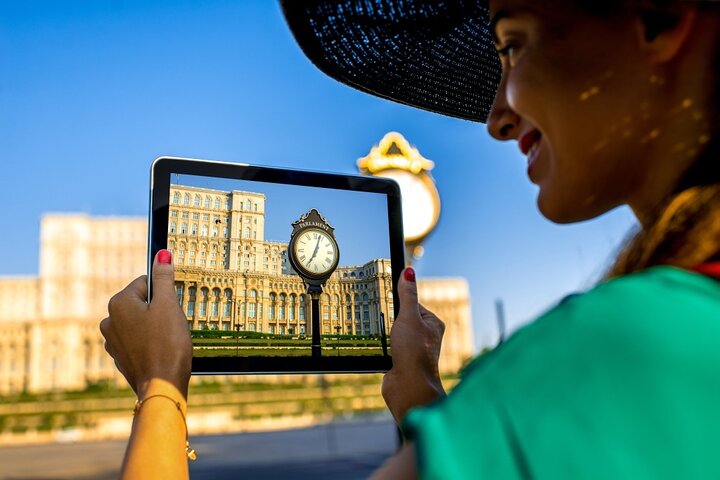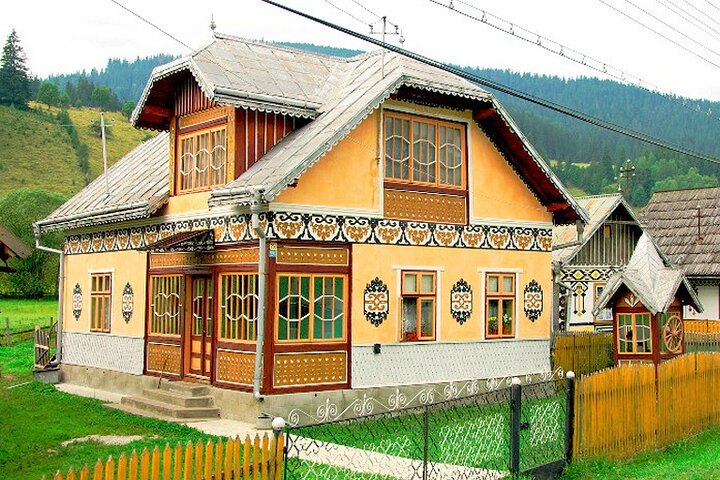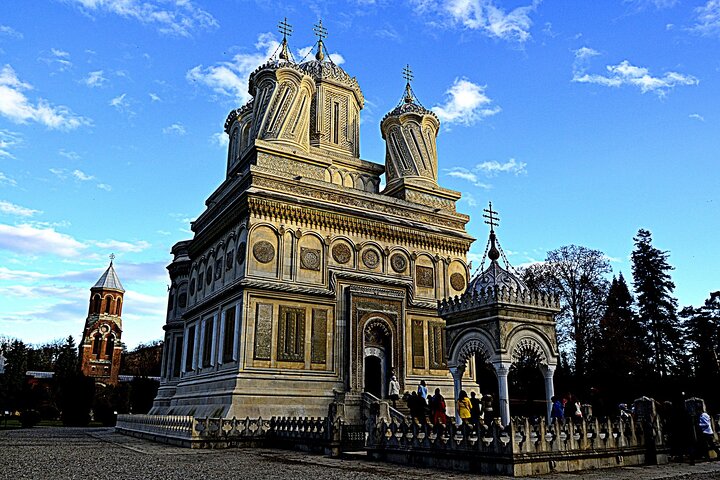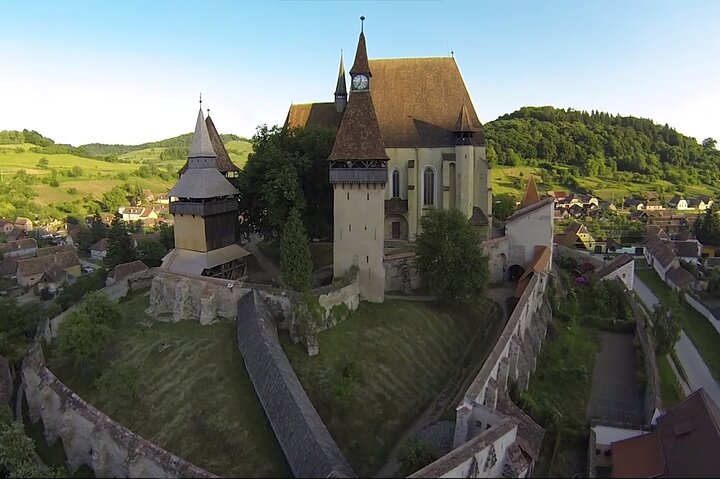From Bucharest: 15 Days Romania, Moldova & Transnistria Private Tour
Share this tour

Offered languages
- German
- Japanese
- English
- Italian
- French
- Spanish
It’s the best way to understand Romania and the Romanians by spending 2 nights on a Guest House in Maramures and then drive to Republic of Moldova for 2 nights (plus Transnistria) to see the old Romanian territory plus Danube Delta – Private Tours 15 Days – Complete Romania & Moldova!
An adventure of a lifetime! For this 15-day tour of Romania we have chosen an assortment of rich sensory experiences, from medieval sites to a taste of the wilderness, with deep forests, vibrantly colored wildflowers, and fresh mountain air (in the right season), all the way to modern exhibits, and a dash of traditional herbs and spices with the delicious foods we will be trying in every medieval town we visit.
What's Included
Meeting and pickup
Please let us know the pick up time and address! It will be a big help also you phone
number! Thank you!
Itinerary
-
1Palace of Parliament
On a day trip to Bucharest, you can visit one of the most controversial administrative buildings in the world. With this private tour at The Palace of Parliament or People’s House, you will learn how dangerous and damaging it can be for a nation to let a totalitarian regime like communism take over. In front of one of the biggest constructions in the world, you will feel small seeing what pointless opulence and megalomania “the sleep of reason” can create. Taking a selfie up-close will prove difficult, because you will be trying to capture the second-largest administrative building on the planet, after the Pentagon, and that it will be an experience you will be able to share with your grandchildren.
2 hours • Admission ticket not included -
2Muzeul National al Satului "Dimitrie Gusti"
In this private tour, you can visit The Bucharest National Village Museum and in one place you will see an embodiment of Romanian traditions and you will learn what it meant for Romanian villagers to have built an ecological and sustainable environment in their backyard. You will also get a glimpse of their simple and modest lifestyle, in social and spiritual harmony with their surroundings.
1 hour • Admission ticket not included -
3Ateneul Roman
Next, your private tour will be at the Romanian Athenaeum. Here you will find yourself in front of the most representative symbol of Romanian culture, often considered a symbol of Bucharest as well.
45 minutes • Admission ticket not included -
4Piaka Revolukiei
If you are planning a city break in Bucharest, you must visit The Revolution Square, a place with great historical significance. Here you can be transported back in time to the moment where the dictator Ceausescu was ousted, leaving behind the secrets of a great fortune and controversies about the state security service and his offshore accounts. As we mentioned earlier, when we reach the Senate Palace, you will see the building which used to house the Central Committee of the Romanian Communist Party and the place where the Revolution of December 1989 started, a major historical event whereby, through human force and sacrifice, Ceausescu was removed from power for good.
45 minutes • Admission ticket not included -
5Old Town
In a Bucharest day trip, you have the chance to relive the olden days through a blend of mystery and contrasts on the streets of the Historical City Centre, starting with Hanul lui Manuc, an immense fortified inn which served as a cultural and economic center back in the day. It was built around 1806 by Manuc Bei, one of the wealthiest landowners in the Balkans, and it was where merchants passing through Bucharest would get together, as just a part of the colorful crowd that populated the historical inn. In this historical and cosmopolitan area, with the help of your private guide from Nicolas Experience Tours you will also find, in addition to the most popular restaurants in Bucharest, museums, old and spectacular churches, and an experiential library, where you can purchase books, music and other souvenirs that will make for an unforgettable experience for you and your loved ones.
2 hours • Admission ticket free -
6Curtea de Arges Monastery
Did you know that Curtea de Arges is unique for the important royal tombs it hides? Everyone knows that truly good, beautiful and durable things come only through sacrifice, which will become apparent when you reach the old town of Curtea de Arges. With a rich and eventful history, this is where you get to see the ruins of the Wallachian princely court, the 13th century Royal Church, as well the famous Arges Monastery, an important historical monument with an interesting, yet sad story.
45 minutes • Admission ticket not included -
7Poienari Castle
The ruins of Poienari Fortress stand high on a cliff overlooking the Arges River, at the foothills of the Carpathian Mountains. Built at the beginning of the 13th century by the first Walachian rulers, the castle changed names and residents a few times over the decades; eventually, it was abandoned and left in ruins. recognized the potential of the location and upon taking over the throne, he ordered that the structure be repaired and consolidated, turning it into one of his main fortresses. When the Turks attacked and captured the castle in 1462, Vlad escaped via a secret passageway leading north through the mountains.
2 hours • Admission ticket not included -
8Transfagarasan Highway
More than 150 kilometres in length the Transfagarasan Highway is Romania’s most spectacular and best known road and, thanks to an appearance on BBC Top Gear in 2009, now one of the country’s most popular tourist attractions. Fully open only from June to October, the road’s highest point is at 2042 metres: the tunnel which links the northern and southern sides at Lake Balea (Balea Lac).
2 hours • Admission ticket free -
9Big Square (Piata Mare)
If you are in Transylvania, Sibiu is a must visit travel destination with a history of 900 year. A city tour to help you understand why Sibiu was elected as the European Capital of Culture, it includes the Evangelical Cathedral, the Sibiu Old City Center and the town itself, which are among the most visited tourist attractions in Romania, because they cater to every taste and provide a wonderful travelling experience for even the pickiest of tourists. If you love authentic cultural experiences, whether you are more romantic or more adventurous, here you will find everything you need to relax and enjoy yourself, leave the stress of your everyday life behind, and have a fun and memorable trip. The beauty of this old citadel, having received record-breaking recognition, stems from its architecture, the arrangement of the streets, its cultural and artistic heritage, and its beautiful natural scenery, as the town is flanked on two sides by the mountains Fagaras and Lotru.
2 hours • Admission ticket free -
10Castelul Corvinilor
Corvin Castle, also known as Hunyadi Castle or Hunedoara Castle (Romanian: Castelul Huniazilor or Castelul Corvinilor; Hungarian: Vajdahunyadi vár), is a Gothic-Renaissance castle in Hunedoara, Romania. It is one of the largest castles in Europe and is featured as one of the Seven Wonders of Romania.
2 hours • Admission ticket not included -
11Densus Church
The Densuș Church (also known as St Nicholas' Church) in the village of Densuș, Hunedoara County is the oldest stone church in Romania. It was built in its present form in the 13th century on the site of a 2nd-century Roman temple, with some materials from the Dacian Sarmizegetusa fortress. It has a stone tower above the naos. Inside the church there are 15th century mural paintings that show Jesus wearing Romanian traditional clothes. These paintings were made by artist Ștefan. In the 18th century more paintings were added by Simion de Pitești.
45 minutes • Admission ticket not included -
12Sarmizegetusa Regia
Sarmizegetusa Regia, also Sarmisegetusa, Sarmisegethusa, Sarmisegethuza, Ζαρμιζεγεθούσα (Zarmizegethoúsa) or Ζερμιζεγεθούση (Zermizegethoúsē), was the capital and the most important military, religious and political centre of the Dacians before the wars with the Roman Empire. Erected on top of a 1200 m high mountain, the fortress, comprising six citadels, was the core of a strategic defensive system in the Orăștie Mountains.
3 hours • Admission ticket not included -
13Black Church (Biserica Neagra)
Next, journey to the beautifully-preserved medieval town of Brasov, in the foothills of the Carpathian Mountains. Your guide will lead you on a walking tour of the Old Town, where you’ll discover the Black Church, the Old Town square, and city walls built in the Middle Ages. You’ll have free time to absorb the unparalleled atmosphere in one of Brasov’s many charming cafés.
2 hours • Admission ticket not included -
14Bran Castle (Dracula's Castle)
Bran Castle, between myth and history.. Because his fictional portrayal of Dracula’s castle matches Bran so closely, it is widely believed that Bram Stoker must have used descriptions of it to create the fictitious home of Count Dracula. Outside the castle, you’ll have the chance to try an array of traditional foods: handmade cheeses, pálinka (plum and pear brandy), and traditionally-produced ham and sausages.
2 hours • Admission ticket not included -
15Peles Castle
Once upon a time there was a beautiful castle… If have decided to write your memoirs or you want to brag about having seen the most beautiful castles in Europe, the Romanian royal family’s summer residence is, by far, one of the most important tourist attractions in Romania and in Europe, and you will soon understand why. Every year, thousands of important figures and hundreds of thousands of tourists book tours of Romania for this attraction alone, to admire its beauty and at least for a few hours, feel like royalty.
2 hours • Admission ticket not included -
16Village de Viscri
Viscri is best-known for its white fortified church, first mentioned in 1400 as Alba Ecclesia. Like most monuments of the time, the church went through different construction phases. The local Szekler population was the first to build a small church on the site in the early 12th century. Decades later, the German colonists took over control of the land and started a new chapter in its history. During the 13th century, they built the main tower on the west side and enlarged the nave of the church towards the east. Its fortification started later, during the 15th century, and is partially preserved until today. Parts of its fortification elements were demolished after the Ottoman threat disappeared or were used for more peaceful purposes like storage rooms and kindergarten space.
2 hours • Admission ticket not included -
17Cetatea Rupea
Rupea Fortress (Romanian: Cetatea Rupea, German: Burg Reps, Hungarian: Kőhalmi vár) is a medieval fortress built by Transylvanian Saxons and first mentioned by a 1324 document. It is situated on a 120 m high basalt cliff, to the west of the Transylvanian town of Rupea in Romania.The fortress is located on DN13, 70 km from Brașov, on the road to Sighișoara. It was restored in 2010–2013 and as of 2014, it was visited each month by more than 10,000 tourists.
1 hour • Admission ticket not included -
18
We start the tour of Sighisoara Old Town and we’ll have the chance to visit Clock Tower, and Arms museum. If you want to go back in time and catch a glimpse of what life was like in the Middle Ages, you absolutely have to visit Sighisoara, Romania’s medieval town, and Count Dracula’s (actually, Vlad the Impaler) place of birth. Built in 1280, the Sighisoara Citadel is not just one of the most visited tourist attractions in Romania, it is a living, breathing medieval fortress, since it has remained inhabited for over 700 years – which is quite rare.
3 hours • Admission ticket free -
19Salina Turda
Turda Salt Mine it’s probably one of the most interesting places to see in Transylvania. If you have the chance to take spend your vacation in Romania, it would be a shame to not venture into one of its most beautiful places, the Turda Salt Mine. This place is a feast for the eyes and the body, as your lungs will be very grateful for the purifying saline air, beneficial especially for those with respiratory problems, such as allergies or asthma.
2 hours • Admission ticket not included -
20Gradina Botanica "Alexandru Borza"
If you pass through Transylvania during your trip to Romania, a Cluj Napoca City Tour should definitely be on your itinerary. Get your camera ready, because the Old City Center features a number of unique historical and architectural monuments, Baroque, Renaissance and Gothic-style buildings, the oldest of which date back to the 17th century, as well as friendly and welcoming people. Not to mention the restaurants and the delicious local cuisine, which are so popular that you might have to wait in line before you can get a table and enjoy your meal.
2 hours • Admission ticket not included -
21Surdesti Wooden Church
Nothing compares to the characteristic warmth that wooden constructions exude, but the Surdesti church has a lot more going for it. People who see it are so awe-stricken they tip their hats off – not exactly a joke, considering the church’s towers measures an impressive 54 meters. Imagine the kind of artwork and craftsmanship that must have gone into this 72-meter high wooden gem, a difficult task even with modern day technology, and when you think it was built in 1721, you can understand why it is considered an architectural masterpiece.
1 hour • Admission ticket not included -
22Merry Cemetery
We have mentioned history, culture and adventure, but this trip to Romania is also guaranteed to include some fun. Dacians, our brave and wise ancestors who worshiped the god Zalmoxis, would laugh at funerals and cry when babies were born. Here in Maramures you can still find traces of historical continuity, most notably in Sapanta, home of the one and only Merry Cemetery. The crosses and tombstones, each a skillful and colorful work of art, bear humorous poems about the deceased that will have you in stitches.
1 hour • Admission ticket not included -
23Memorial of the Victims of Communism and of the Resistance
If you want to know why the Romanian people fought so hard to escape the communist oppression, pay a visit to the Memorial Museum for the Victims of Communism and you will only begin to understand how damaging the totalitarian regime was and how much pain and suffering it brought in such a short time.
2 hours • Admission ticket not included -
24Barsana Monastery
One of the tallest wooden church in Romania (57m height) In the same way you feel the eternal, primordial connection with the earth when you walk barefoot through the grass, you will experience a spiritual connection with the sky and God as you step into the courtyard of the most beautiful wooden monastery in Romania, the Barsana Monastery. If you think you have seen astonishing places before, of such divine beauty that you felt they were a piece of heaven on earth, this trip to Maramures might have you reconsider. With its fairytale scenery and timeless history, this magical place has fascinated both tourists and locals for hundreds of years.
45 minutes • Admission ticket not included -
25
Tihuța Pass (Romanian: Pasul Tihuța, also called Pasul Bârgău; Hungarian: Borgói-hágó or Burgó) is a high mountain pass in the Romanian Bârgău Mountains (Eastern Carpathian Mountains) connecting Bistrița (Transylvania) with Vatra Dornei (Bukovina, Moldavia). The pass was made famous by Bram Stoker's novel Dracula, where, termed as "the Borgo Pass", it was the gateway to the realm of Count Dracula. Stoker most likely found the name on a contemporary map; he never actually visited the area. Today the pass is home to Hotel "Castel Dracula"; located at an elevation of 1,116 m (3,661 ft), the hotel was built in 1976 and adopted its current name after 1989. The hotel has become quite an attraction due to its architectural style of a medieval villa, as well as the connection to the novel. In 2018 the property was put up for sale
2 hours • Admission ticket free -
26
Ciocănești village located in the southwestern part of Suceava county (Bukovina, northern Romania) is renowned for its merry painted houses, adorned with traditional motifs. A real touristic village now, Ciocănești is lying on both sides of the Golden Bistrița River and is surrounded by scenic pine spruce forests and fertile meadows. It is close to the Vatra Dornei resort, only 22 km away, and 100 km away from Suceava city, on Iacobeni-Borșa road.
1 hour • Admission ticket included -
27Manastirea Voronet
The Voroneț Monastery is a medieval monastery in the Romanian village of Voroneț, now a part of the town Gura Humorului. It is one of the famous painted monasteries from southern Bukovina, in Suceava County.[1] The monastery was constructed by Stephen the Great in 1488 over a period of 3 months and 3 weeks to commemorate the victory at Battle of Vaslui. Often known as the "Sistine Chapel of the East", the frescoes at Voroneț feature an intense shade of blue known in Romania as "Voroneț blue."[1] Did you know that Voronet Monastery was founded by Stephen the Great? Dubbed as the “Sistine Chapel of the East”, it attracts tens of thousands of tourists from around the world every year, having at least three unique elements that make it one of the highlights of your trip through Moldavia and Bucovina. The most impressive aspect of the church’s artwork, both on the inside and on the outside, is the exceptional background color – the famous Voronet blue!
1 hour • Admission ticket not included -
28Humor Monastery
In order to understand how important religion has been for our people, you have to take a tour of Romania and see the sheer number of houses of worship that have been built, but also destroyed by enemies over the course of history. Striving to protect their spiritual treasures, people erected churches away from the eyes of the world, some of them hidden in the depths of the woods, others nestled within rock caves at high altitudes. Humor Monastery, which was built approximately 500 years ago, is an example of a fortified monastery that has managed to endure over the centuries. After the first church that stood here, built around 1400, was destroyed, the second one, built in 1530 with thick river rock walls, was meant to be a place of worship that would withstand the test of time.
1 hour • Admission ticket not included -
29Sucevita Monastery
Sucevita and Voronet are two of THE MOST BEAUTIFUL ROMANIAN MONASTERIES, part of the international cultural and spiritual patrimony, which is why they should be included in any trip to Romania and northern Moldavia. Even if you have not read the Bible, or the Book of Books, the biblical scenes and icons painted on the walls of the Sucevita Monastery will give you a stunning and vivid visual support in understanding the history of Christianity. The fortified church is like an open book for anyone who enters its doors, and only once you see it in person will you truly understand why it was included on the UNESCO World Heritage list of cultural landmarks.
45 minutes • Admission ticket not included -
30Moldovita Monastery
If you want to take a spiritual journey to a place that still echoes with the fervent prayers of the hundreds of thousands of people that have found solace here over the course of history, take your adventure through the Carpathians and Balkans to one of the oldest monastic settlements in Romania, built in 1532, home of the Moldovita Monastery. The fortified church combines elements of Byzantine, Gothic and Moldavian style, but what truly impresses visitors is its unique mural artwork, on both the inside and the outside of this beautiful house of worship.
45 minutes • Admission ticket not included -
31The Popa Museum
12 kilometers away from Targu Neamt, in Tarpesti, Neamt County, you can visit an interesting and notable sight, Nicolae Popa Museum. The museum was founded in the ‘70s by the local sculptor Nicolae Popa, in his own house. After being wounded in the Second World War, imprisoned by the communists for fighting against the regime and left without any personal possessions besides his house, Nicolae Popa decided to stand out for the Romanian values. With hard work and commitment, driven by a strong native inclination for art, he becomes one of the most valued and appreciated naive sculptors in Romania and a true creator of folklore.
1 hour • Admission ticket not included -
32
Mănăstirea Trei Ierarhi (Monastery of the Three Hierarchs) is a seventeenth-century monastery located in Iași, Romania. The monastery is listed in the National Register of Historic Monuments and included on the tentative list of UNESCO World Heritage Sites.
2 hours • Admission ticket free -
33The Suvorov Monument
Suvorov is considered one of the greatest military commanders in Russian history and one of the great generals of the early modern period. He was awarded numerous medals, titles, and honors by Russia, as well as by other countries. The monument is located on a small square and nearby; there are a series of flags you won't see anywhere else. Tiraspol is the second largest city in Moldova and the capital of the independent country of Pridnestrovian Moldavian Republic. The city is located on the Northern and Eastern banks of the Dniester River. The city is modern compared to the rest of Transnistria, with good urban transport links. The city is home to hotels and restaurants. Contrary to popular perceptions, Tiraspol is a quiet and peaceful city with no military activity since 1992. The only people in uniform you will usually see are military officers and policemen. Military parades are held annually on Independence Day (2 September) and on Victory Day (9 May).
2 hours • Admission ticket free -
34The Tank Monument
This monument is a perfect reminder of the battle and history to make the autonamus region of Transnistria, and the many people who lost their lives to follow their dream!
2 hours • Admission ticket free -
35Cricova Winery
The wine cellars of Cricova are the second largest wine cellar in Moldova, after Milestii Mici (the largest in the world). It boasts 120 kilometres (75 mi) of labyrinthine roadways, versus MM's 200 kilometres (120 mi). Tunnels have existed under Cricova since the 15th century, when limestone was dug out to help build Chişinău. They were converted into an underground wine emporium in the 1950s. Half of the roadways are used for wine storage. The roads are named by the wines they store. This "wine city" has its warehouses, tasting rooms, and other facilities underground. It goes down to 100 metres below ground and holds 1.25 million bottles of rare wine. The oldest wine dates back to 1902. The temperature is maintained at about 12 °C (54 °F) all year round (which is perfect for wine). Legend has it that in 1966 cosmonaut Yuri Gagarin entered the cellars, re-emerging (with assistance) two days later. Russian president Vladimir Putin celebrated his 50th birthday here.
2 hours • Admission ticket not included -
36Catedrala Nasterea Domnului
The Nativity Cathedral, located in Cathedral Park, doesn’t look all that impressive from the outside. Built in the 1830s in the neoclassical style it has a turbulent history – the cathedral was destroyed during World War 2 and when Moldova was part of the USSR and religious services were prohibited the building was used as the exhibition center.
1 hour • Admission ticket not included -
37
The Brăila Bridge is a road suspension bridge in Romania, under construction since 2019 over the Danube river, between Brăila, a major city in eastern Romania, and the opposite bank of the river in Tulcea County. It will be the first bridge over the maritime Danube sector and the fourth bridge over the Romanian section of the river. At nearly 2 km in length, it will be the third-longest bridge in Europe. The bridge will improve road traffic accessibility of the Galați-Brăila area to Constanța and Tulcea, and connections between Moldavia, Muntenia and Dobruja regions.
2 hours • Admission ticket free -
38Danube Delta
Danube Delta Tour – we explore by boat the beautiful nature of Danube Delta - Overnight in Tulcea
6 hours • Admission ticket not included -
39Moscheea Carol I
Carol I Mosque, located in Ovid Square area, is the main religious muslim edifice and one of the most beautiful architectural monuments of our land. The building started in 1910 at the initiative of King Carol I (which is why the building is named so) and was completed in 1913. The inauguration took place on 31st of May in the presence of the royal family and muslim representatives of Romania. The project was conducted by Victor Stefanescu, one of the senior architects of the early twentieth century, and the building was raised by Gogu Constantinescu Sharing a beautiful and unique mixture of Egyptian, Byzantine and Romanian architecture, Carol I Mosque is the first building in our country for whose construction reinforced concrete was used. A distinctive feature of the building is huge dome made of innovative materials listed above. Although many specific Muslim places of worship, is an architectural dome by Christian inspiration, more exactly, Byzantine.
45 minutes • Admission ticket not included -
40
Mamaia is one of the most popular destinations for a beach holiday in Romania. It is on the Black Sea and is an archetypical seaside resort. There are beaches to relax on, nice food and lots of entertainment, including an amusement park.
3 hours • Admission ticket free -
41Cazinoul Constanta
Undergoing many changes throughout its history of over 100 years, the Casino has always represented a point of attraction for the tourists and the locals. Between 1880 and 1890, we hear of Cazin or Kursal as being a wooden building on the seashore, built on a location a few hundred meters away from the current one. Besides the ballroom, noticeable were the reading hall with French newspapers, a games hall, as well as a terrace. It is here that the tourists, the seamen, and the local elite met in the summer evenings to take part in the balls organised by the city hall on the tunes of the brass bands or on the music of the famous artists of the era. Theatrical performances, soirees, conferences, literary readings or masquerade balls also took place at the Cazin. The games of chess, backgammon, or domino completed the bohemian scenery.
1 hour • Admission ticket not included
Bucharest City Tour - Overnight in Bucharest
1. Curtea de Arges Monastery 2. Poienari Castle 3.Transfagarasan Highway - Overnight in Sibiu
1. Corvin Castle 2. Densus Church 3. Sarmisegetusa Regia - Overnight in Sibiu
1. Brasov City Tour (Black Church) 2. Bran Castle / Dracula's Castle 3. Peles Castle - Overnight stay in Brasov
1. Viscri Village 2. Rupea Fortress 3. Sighisoara City Tour - Overnight stay in Sighisoara
1. Turda Salt mine 2. Cluj Napoca City Tour (Botanic Garden) 3. Surdesti Wooden Church - Overnight in Sighetul Marmatiei
1. Explore Maramures all day(local market) 2. Merry Cemetery 3. Sighet Memorial Museum - Overnight in Sighetul Marmatiei
1. Barsana Monastery 2. Borgo Pass Road 3. Ciocanesti village - Overnight in Gura Humorului
1. Voronet Monastery 2. Humor Monastery 3. Sucevita Monastery 4. Moldovita Monastery - Overnight in Gura Humorului
1. Driving to Chisinau (Republic of Moldova) 2. Nicolae Popa Museum 3. Lunch in Iasi - Overnight in Chisinau
Visit to Tiraspol (Transnistria) - Overnight in Chisinau (Republic of Moldova)
Chisinau City Tour with Cricova Wine Cellar & Milestii Mici - Overnight in Chisinau (Republic of Moldova)
1. Start driving crossing Republic of Moldavia for Danube Delta 2. Cross the Danube at Braila - Overnight in Tulcea
Danube Delta Tour – we explore by boat the beautiful nature of Danube Delta - Overnight in Tulcea
1. Constanta Old Town 2. Carol I Mosque 2. Mamaia Beach - Back to Bucharest (End of Tour)
Additional info
- Specialized infant seats are available
- Suitable for all physical fitness levels
Tags
Cancellation Policy
For a full refund, cancel at least 24 hours before the scheduled departure time.
Show more
Cancellation Policy
- For a full refund, you must cancel at least 24 hours before the experience’s start time.
- If you cancel less than 24 hours before the experience’s start time, the amount you paid will not be refunded.
- Any changes made less than 24 hours before the experience’s start time will not be accepted.
You can cancel up to 24 hours in advance of the experience for a full refund.
Your guide to the flawless travel experience








